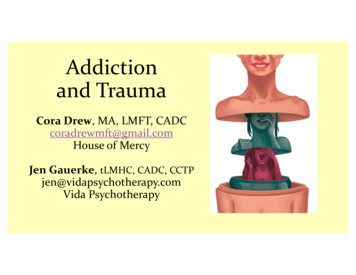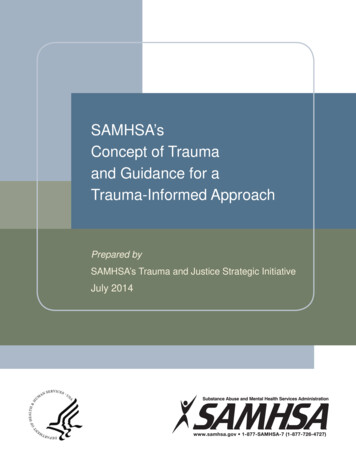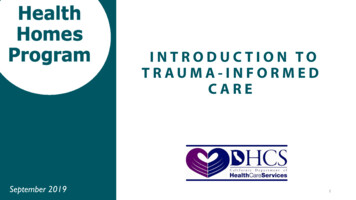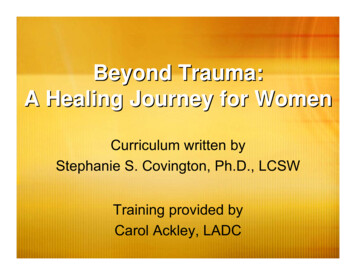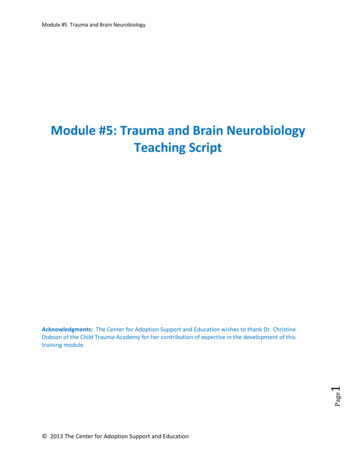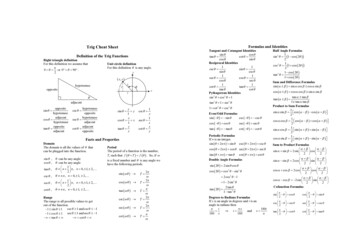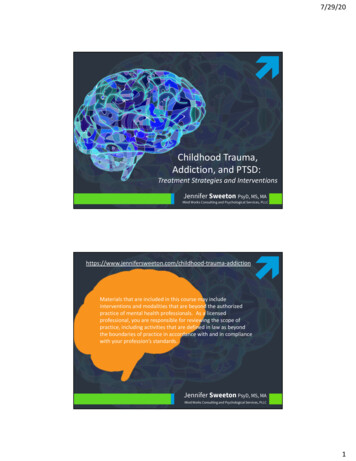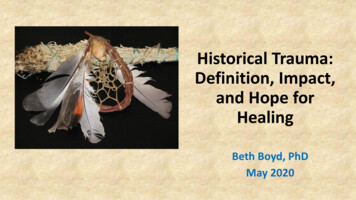
Transcription
Historical Trauma:Definition, Impact,and Hope forHealingBeth Boyd, PhDMay 2020
Three Elements of Historical Trauma1. A trauma or wounding2. The trauma is shared by a group of people, rather thanindividually experienced3. The trauma spans multiple generations, such thatcontemporary members of the affected group mayexperience trauma-related symptoms without having beenpresent for the past traumatizing event(s)
What is Historical Trauma? Cumulative emotional and psychological wounding,over the lifespan and across generations, emanatingfrom massive group trauma experiences Term was originally used to describe the experience ofchildren of Holocaust survivors Has since been used to describe the experience ofcolonized groups across the world and communitieswith a history of oppression, victimization, andmassive group trauma exposure3
Native American Historical Trauma Estimated as much as 95% of Native American populationwiped out through federal policies of removal,termination, relocation, and assimilation and diseasesunfamiliar to the people Resulted in generations of traumatic losses of land,language, culture, community bonds Traditional spiritual and ceremonial ways of healing wereoutlawed until 1978 Left generations of Native people with no mechanism forhealing from the historical traumas4
Historical Trauma“These events don’t just target an individual, theytarget a whole collective community.the trauma isheld personally, and can be transmitted overgenerations. Even family members who do not have adirect experience of the trauma itself can feel theeffects generations later”— Karina Walters, Ph.D.
Impact of Historical Trauma Health disparities, substance abuse, and mental illness areall commonly linked to experiences of historical trauma(Michaels, Rousseau, and Yang, 2010) “Historical Trauma Response” includes high levels ofsubstance abuse, suicide, depression, anxiety, low selfesteem, anger, difficulty recognizing and expressingemotions and unresolved historical grief (Brave Heart,1998) “American Indian holocaust” meets the United Nationsdefinition of genocide
1948 Convention on the Prevention andPunishment of the Crime of GenocideAdopted by Resolution 260 (III) A of the United Nations General Assembly on 9 December 1948Article II: “In the present Convention, genocide means any ofthe following acts committed” A mental element – “with the intent to destroy, in whole or inpart, a national, ethnical, racial or religious group, as such:” A physical element which includes the following 5 acts:1. Killing members of the group2. Causing serious bodily or mental harm to members of the group3. Deliberately inflicting on the group conditions of life calculated tobring about its physical destruction in whole or in part4. Imposing measures intended to prevent births within the group5. Forcibly transferring children of the group to another group7
“Killing members of the group”Community massacres(Wounded Knee, 1890)Deliberate disease exposureForced removals
“Causing serious bodily or mental harm tomembers of the group” Indian Relocation Program of 1956 Boarding School Programs Adoption Projects Prohibition of cultural andspiritual practices
“Deliberately inflicting on the groupconditions of life calculated to bring about itsphysical destruction in whole or in part” Native American Boarding Schools By 1887, 200 boarding schools were established with 14,000Indian children forcibly enrolled “It is this nature in our red brother that is better dead than alive, and when weagree with the oft-repeated sentiment that the only good Indian is a dead one, wemean this characteristic of the Indian. Carlisle's mission is to kill THIS Indian, as webuild up the better man. ” -- Richard Henry Pratt
Carlisle Indian School, PA
“Imposing measures intended to preventbirths within the group” Forced sterilization was a proceduredone by the Indian Health Service(IHS) physicians on Native Americansin the 1960s and 1970s The IHS doctors sterilizedNative American women throughcoercion or without consent using avariety of tacticsJean WhitehorseFilm: AMÁ
“Forcibly transferring children of the group toanother group” The Indian Adoption Project was a federal program that removed Indianchildren from 1958 to 1967 with the help of the prestigious Child WelfareLeague of America As many as one third of Indian children were separated from their familiesbetween 1941 and 1967, according to a 1976 report by the Association onAmerican Indian Affairs During the adoption era almost any issue—from minor to serious—couldresult in the loss of an Indian child
Adverse Childhood Experiences (ACEs)U.S. Center for Disease Control & Prevention Adverse Childhood Experiences is the term used todescribe any abuse, neglect, or other traumatic experiencethat happens to a person under age 18 ACEs have been linked to: risky health behaviors, chronic health conditions, low life potential, and early death
As the number of ACEs increases, so does the riskof health and mental health issues later in lifeU.S. Center for Disease Control & Prevention
The “Ecobiodevelopmental Model” The field of epigenetics suggeststhat clues from our physical,social and emotionalenvironment literally alter theway the inherited geneticblueprint is read In this way, the early childhoodecology is biologically embedded– altering the way the blueprintis utilized in this generation aswell as the next.
Historical Trauma at All Levels Individual Level Many negative health and mental health outcomes Family Level Children try not to trigger painful memories for parentsAvoid bringing up their own problemsLoss of traditional parental role models, child-rearing practicesInternalized messages about appropriateness of raising children in homes Community Level Assaults on tribal sovereignty and traditional practices, weakened socialstructures Losses of language, traditional practices, vision for the future, “way of life” The community is “wounded”
Wounded Community When the whole community is wounded, it can’t functionin the ways it was intended All that is felt is the loss People try to fill that loss with other things Traditions are not available to help keeprelationships healthy The trauma continues to roll forward like a wave overgenerations To stop this forward momentum, some form of socialhealing is needed where the losses are mourned and replaced by somethingnew and healthy in the community
Resilience Historical traumas may have long-lasting effects on individual, family,and community health and mental health But we can also understand historical traumas as potential sources ofboth distress and resilience Individual, family and community histories of survival Native communities have survived a history of traumatic events,including disease, warfare, colonization, cultural genocide, poverty But there is are equally powerful stories of resistance andresilience
Healing: Connection to Culture toHeal Wounds
Hope and Healing The painful and traumatic experiences that many of us have had andwhich we have inherited from past generations might mean that wewould never have a chance in this life But the spirit yearns for growth and connection Can find that connection even when we think we cannot Leads us to have the courage to walk through our fears Resilience: culturally learned values and practices that promotecoping mechanisms and adaptive reactions to trauma
Wellness is About Balance Wellness involves a balancebetween the Creator, the naturalworld, and the physical, mental,emotional and spiritual aspects ofthe self Imbalances in any of these areas mayresult in individual or communal “disease” or illness Healing is a communal process of(re)discovering balance within selfand the harmony between self,Creator, and the natural world
Personal Responsibility for Wellness Whether we participate in traditional cultural forms of healing orvisit a Western provider The process of identifying those things we need or seek to change,deciding to ask for help, and humbling oneself to receive healing Recognizing we are no more – and no less – than anyone else; weare the people Recognizing the spark of the Creator in ourselves and others Giving thanks and giving back for what we receive
Community is at the Center of Wellness Individual health cannot be separated from communitywellness Emphasis on extended family and community rather thanindividual Group/community identity Strong cultural identity linked to resilience Healing is a community process Value is on community welfare (past and future) Responsibility to generations before and after us Current relationships with the ancestors guide the present Historical continuity provides expanded demonstration ofresilience
Connection to the Earth Not just a connection to Nature Realization that healing is connected to the land and the water assources of our healing Also why the loss is so devastating Knowing that our medicines come from the earth From the same spark of the Creator Our bodies recognizes it Our wellness is connected to the wellnessof our relatives -- land and water and air
Healing is a Process of Re-connection
The Culture Is the Medicine Within the context of any of our indigenous ceremonies, there aremultiple lessons which: Might be the focus of Western mental health prevention or interventionactivities Provide important teachings about community and for community membersof all stages of life Teach us how to deal with loss, conflict, leadership, giving encouragement,and giving thanks Help us to remember who we are “We can call back our spirit to this day and not be stuck in what happened in thepast – or what we wish for the future.” - Gene Thin Elk
References Brave Heart, M. Y. B., & DeBruyn, L. M. (1998). The American Indian Holocaust:Healing historical unresolved grief. American Indian and Alaska Native MentalHealth Research, 8, 56-78. "Investigation of Allegations Concerning Indian Health Service". GovernmentAccountability Office. November 4, 1976. Addressed to the Honourable SenatorJames Abourezk. Lawrence, J. (2000). The Indian Health Service and the Sterilization of NativeAmerican Women. American Indian Quarterly, 24(3), 400-419. Retrieved fromhttp://www.jstor.org/stable/1185911 National Center for Injury Prevention and Control, Division of Violence Prevention,Center for Disease Control & childabuseandneglect/acestudy/index.html Torpy, S. “Endangered Species: Native American Women’s Struggle for TheirReproductive Rights and Racial Identity, 1970 to 1980s” (Master’s Thesis, Universityof Nebraska, Omaha, 1998.)
Adverse Childhood Experiences (ACEs) U.S. Center for Disease Control & Prevention Adverse Childhood Experiences is the term used to describe any abuse, neglect, or other traumatic experience that happens to a person under age 18 ACEs have been linked to: risky health behaviors, chronic health conditions, low life potential, and




